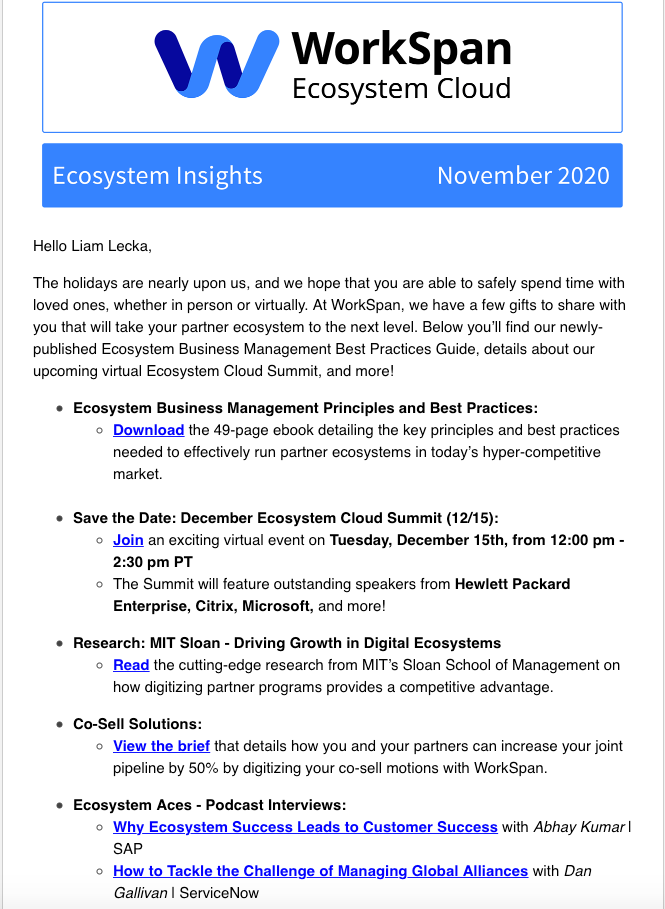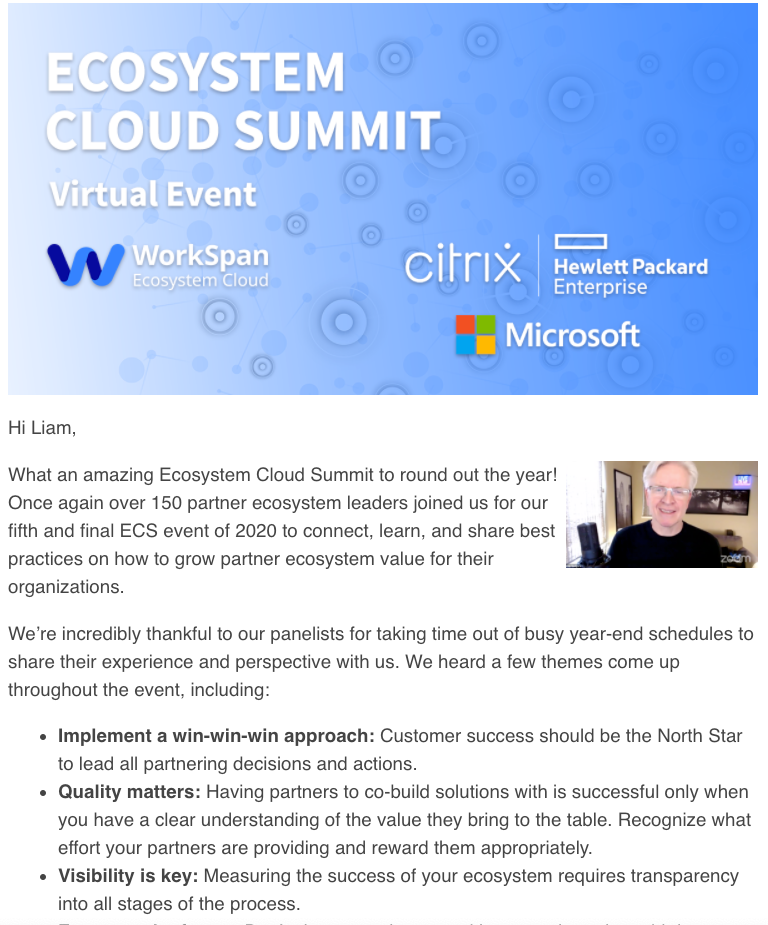Workspan
Marketing Internship
Background
WorkSpan is a B2B technology startup located in the San Francisco Bay Area. They provide proprietary SaaS for tech partners to collaborate on a single platform to develop co-selling, joint solutions, joint marketing, and other complex partnering motions. I was introduced to WorkSpan through Medill's Journalism Residency program, which allowed me to gain hands-on marketing experience while earning course credit. The program lasts a quarter (10 weeks), though I was fortunate to extend my internship with WorkSpan an additional 3 weeks. The WorkSpan marketing team is a small but mighty group of 4 highly motivated individuals, and I was able to work with each of them across content design and strategy, product marketing, customer marketing, and demand generation.
Roles / responsibilities
Throughout my time at WorkSpan, I wore multiple hats as the marketing intern, which is common in startup environments. My responsibilities included drafting product update and user announcement emails, developing blog posts (including ghostwriting for executives), writing solution briefs, research, and assisting in hosting virtual events for the partner ecosystem audience.
Product / Audience emails
As I became more familiar with the technical B2B knowledge required to address WorkSpan's audience, I was given the space to create the copy for multiple product and audience emails.
For product, I worked with both the marketing and project management teams to help standardize the process and cadence of creating product update emails each month. Additionally, I developed an A/B test to implement each month and analyzed results to generate actionable insights for increasing our open and click-through rates.
For WorkSpan's audience, I wrote monthly Ecosystem Insights newsletters to 25,000+ people in the partner ecosystem community. These emails chronicled industry highlights as well as new content from WorkSpan, including announcements about our virtual events, solution briefs, and podcasts. After each Ecosystem Cloud Summit event, I was also tasked with recapping the 2+ hour event with highlights/quotes from each session as well as themes that emerged.
Examples these three emails are shown below.



Creating Blog Posts
Beyond emails, much of my time with content creation at WorkSpan was spent creating and executing blog concepts. Some were recurring, as seen with the Best Practices blogs (below right). I took podcasts that our VP of Marketing created and distilled their essence into Best Practices posted to our community site Ecosystem Aces. Others were larger efforts, like the 35 Innovative Leaders to Follow blog (below left) that was developed over a month. This blog was called my "opus" as it consisted of researching extensively into leaders in the partner ecosystem community, working internally to judge and determine our list, expanding the list from 25 to 35, writing biographies about each one, and including content and accolades for each. The final result was posted to the WorkSpan.com and LinkedIn, and continues to be one of the highest-traffic pages on the site.
Solution Briefs
In order to assist our Sales team, the Marketing team was responsible for developing assets they could easily share and generate interest from. This included case studies, solution briefs, slide decks, and comprehensive packages. I was able to assist in the creation of solution briefs by taking the slide decks and other information on hand and turning them into a story about each of WorkSpan's selling points. Below is the final version of the Co-Sell Solution brief I drafted.
Research
One of my favorite parts of working with a startup is that you are not confined to completing tasks in a particular way. When it came to demand-generation, I knew there had to be a better way than searching and extracting emails by searching individual profiles, and then sending those emails (and follow-ups) manually. Over my 13 weeks, I developed and optimized a process for searching and finding potential customers using LinkedIn's Sales Navigator (below right) and the email extraction tools Wiza and Lusha. I then sought out and secured a new tool, Mailshake (below left), for the team to send hundreds of emails at a time and keep track of any leads that come from it. Ultimately this drastically cut the time it took to send and reply to demand-generation emails each week. Additionally, I completed competitive landscape, market, and customer research to aid in the creation of content across all mediums.
Tools Used
Google Suite, Adobe Suite, LinkedIn Sales Navigator, Wiza/Lusha, Mailshake, Intercom, Hubspot, Salesforce